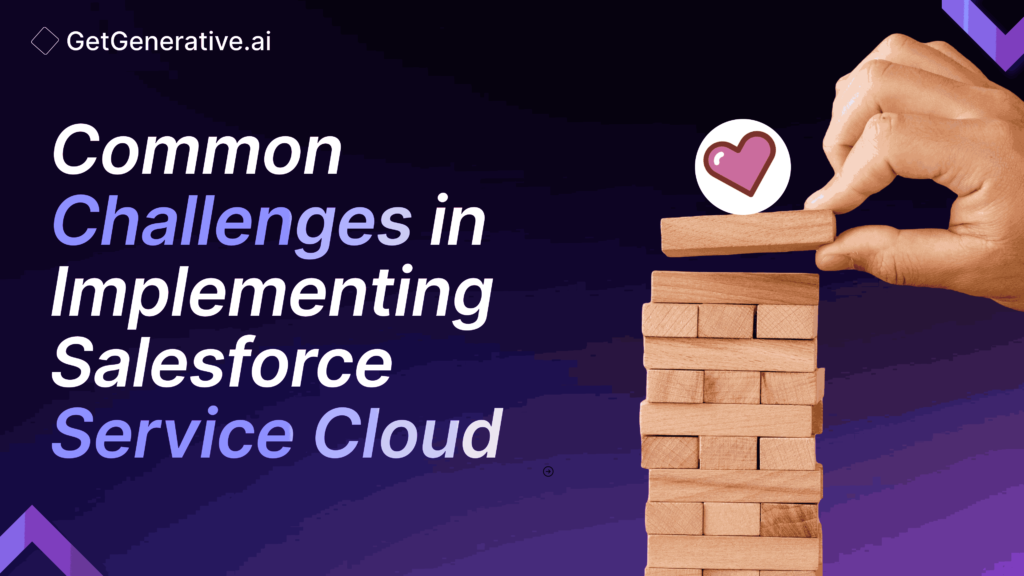Common Challenges in Implementing Salesforce Service Cloud
Implementing Salesforce Service Cloud has its challenges. Below, we’ll delve into the most common and significant challenges businesses face during Salesforce Service Cloud implementation, offering a detailed overview of each and why they matter.
Top Challenges in Implementing Salesforce Service Cloud
1. Lack of Clear Objectives and Vision
A successful implementation begins with a well-defined vision and clearly articulated goals. However, many organizations need to fully understand their intended outcomes before deploying Salesforce Service Cloud. This lack of clarity leads to poorly planned strategies, misaligned processes, and ultimately, unsatisfactory outcomes.
Why it Happens:
- Businesses may lack a detailed roadmap outlining their goals.
- Teams might focus too much on the tool’s features rather than aligning its capabilities with business objectives.
- Stakeholders often have conflicting expectations, leading to miscommunication and mismatched priorities.
Impact: Without clear objectives, teams may implement features that are unnecessary, miss critical functionalities, or fail to measure success effectively. This often results in wasted resources and reduced ROI.
Solution: Define measurable goals, such as improving first-response times, increasing customer satisfaction scores, or enhancing agent productivity. Create a strategic roadmap that aligns with these goals and ensures every stakeholder is aligned and informed about the process.
2. User Adoption Challenges
One of the most underestimated challenges of implementing Salesforce Service Cloud is getting employees to use it effectively. User adoption is critical to ensuring the platform delivers its intended value. Unfortunately, resistance to change and inadequate training can severely hamper this.
Why it Happens:
- Employees may feel overwhelmed by the platform’s new interface and features.
- Organizations often prioritize the technical setup while neglecting training and onboarding.
- Teams may see the tool as an additional burden rather than a productivity booster.
Impact: Low user adoption results in underutilization of the platform’s features, reduced productivity, and slower customer response times.
Solution: Implement a robust change management strategy. Involve employees from the start, provide hands-on training, and offer continuous support. Highlight how Salesforce Service Cloud simplifies their tasks and improves customer service.
3. Data Migration and Integration Issues
During Salesforce Service Cloud implementation, migrating data from legacy systems and integrating it with existing tools can be a daunting task.
Why it Happens:
- Legacy systems may contain duplicate, incomplete, or outdated data, which complicates migration.
- Integration with existing tools like ERP systems or communication platforms often requires extensive customization and technical expertise.
- The absence of a structured migration plan can result in critical errors or even loss of valuable data.
Impact: If not handled properly, data migration and integration issues can delay the implementation process, compromise data integrity, and disrupt service operations.
Solution: Start with a comprehensive data audit before migration. Organize and clean the data meticulously to remove redundancies and ensure accuracy. Use experienced data migration specialists and tools to ensure a smooth transition. For integrations, leverage Salesforce APIs and middleware to connect existing systems seamlessly.
4. Over-Customization Complexities
Salesforce Service Cloud offers extensive customization options, which is both a strength and a potential pitfall. Excessive customization can complicate the system, making it cumbersome, less efficient, and harder to maintain in the long run.
Why it Happens:
- Organizations may try to tailor every aspect of the platform to their needs without considering long-term usability.
- Stakeholders may request features that are not essential but add complexity.
- Lack of guidance from experienced Salesforce consultants can result in poorly designed customizations.
Impact: Over-customization makes the system harder for agents to navigate, reducing efficiency and adoption rates. It also increases implementation costs and maintenance overheads.
Solution: Focus on essential customizations that align with business goals. Maximize the use of built-in features whenever possible and seek guidance from seasoned Salesforce consultants to ensure customizations are both necessary and efficient.
Also, Read – Top Features of Salesforce Service Cloud
5. Security and Compliance Concerns
With customer data at the core of Salesforce Service Cloud, ensuring its security is a critical challenge. Breaches in data security and non-compliance with regulations can undermine customer confidence and expose businesses to serious legal consequences.
Why it Happens:
- Companies may not have robust security protocols in place during implementation.
- Inadequate training on data handling practices increases the risk of errors.
- Cybersecurity threats, such as phishing and malware, pose ongoing risks.
Impact: Security lapses can lead to significant financial losses, legal entanglements, and damage to a company’s reputation. Such incidents can erode customer trust, which is often challenging to rebuild.
Solution: Implement a robust security framework that includes encryption, multi-factor authentication, and regular audits. Educate staff on compliance standards, such as GDPR and CCPA, to maintain secure data handling practices.
6. Reporting and Analytics Challenges
Salesforce Service Cloud offers robust reporting capabilities, but many businesses struggle to leverage them effectively. Without meaningful insights, businesses cannot make informed decisions or improve their customer service strategies.
Why it Happens:
- Teams may not be trained to use Salesforce reporting tools.
- Poor data quality can lead to inaccurate reports.
- Overwhelming dashboards may confuse agents instead of providing actionable insights.
Impact: Lack of proper reporting limits visibility into customer behavior and agent performance, hindering decision-making and service improvements.
Solution: Simplify dashboards and provide training on generating and interpreting reports. Regularly validate data to ensure accurate insights and use reporting tools to track KPIs effectively.
7. Inadequate Implementation Partner Selection
Selecting the right implementation partner plays a vital role in ensuring Salesforce Service Cloud’s success. A partner lacking sufficient expertise and experience can lead to unsatisfactory outcomes.
Why it Happens:
- Businesses may prioritize cost savings over quality and expertise.
- Some partners need a deeper understanding of the Salesforce ecosystem or specific industry needs.
- Poor communication and weak project management can result in delays, budget overruns, and unmet expectations.
Impact: An inexperienced implementation partner can cause project delays, budget overruns, and incomplete implementations, reducing the overall ROI.
Solution: Evaluate implementation partners based on their certifications, experience, and client reviews. Choose a partner with a proven track record in Salesforce Service Cloud implementations and a strong understanding of your industry’s needs.
8. Limited Post-Implementation Support
The journey doesn’t end with implementation. Ongoing support is crucial to ensure the platform evolves with your business needs.
Why it Happens:
- Companies may overlook the need for post-implementation services during the planning phase.
- Lack of dedicated support teams for troubleshooting and updates.
Impact: Without proper post-implementation support, businesses may struggle with system maintenance, user adoption, and future upgrades.
Solution: Partner with a vendor that offers comprehensive post-implementation support, including regular updates, training refreshers, and scalability planning.
Strategies to Overcome These Challenges
Implementing Salesforce Service Cloud may be challenging, but these strategies can set you up for success:
- Set Clear Goals: Establish measurable objectives and communicate them across teams.
- Invest in Training: Provide continuous training to ensure employees are confident using the platform.
- Plan Data Migration: Cleanse, validate, and organize your data before migration to prevent disruptions.
- Tailor Customizations: Focus on essential features and avoid over-complicating workflows.
- Engage Experts: Work with seasoned implementation partners to guide you every step of the way.
- Ensure Security: Adopt strict data security measures and educate employees on compliance practices.
Also Read – Salesforce CRM Implementation With AI – The Ultimate Guide
Conclusion
Implementing Salesforce Service Cloud is no small feat, but the rewards are worth the effort. By proactively addressing these challenges, businesses can harness the full capabilities of Salesforce Service Cloud and elevate their customer service operations. Ultimately, success extends beyond adopting the platform—it’s about fundamentally transforming customer engagement strategies.
To learn more, visit GetGenerative.ai today!
FAQs
1. What are the most common Salesforce Service Cloud implementation challenges?
Challenges include poor user adoption, data migration issues, over-customization, security concerns, and lack of clear objectives.
2. How can I ensure successful user adoption of Service Cloud?
Provide comprehensive training, involve employees early in the process, and highlight how the platform simplifies their workflows.
3. What are the risks of over-customizing Salesforce Service Cloud?
Over-customization can make the system complex, leading to confusion among users and decreased productivity.
4. Why is data migration a critical aspect of Salesforce implementation?
A smooth data migration ensures accuracy and prevents disruptions in customer service operations.
5. How can I choose the right Salesforce implementation partner?
Look for partners with extensive experience, proven success stories, and a deep understanding of your industry’s needs.




